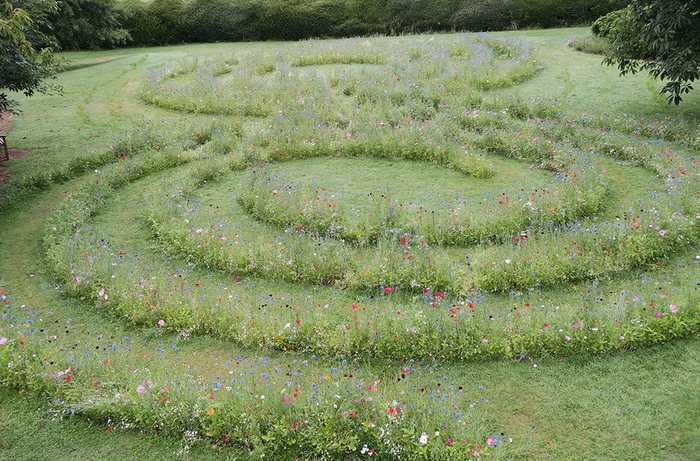Creating A Corner Of Wildness

One of the highlights in the garden this Summer has been a corner of wildness – interlocking wildflower swirls woven with a mix of over thirty different blooms providing pollen and nectar for butterflies and bees and a long lasting display with a succession of different flowers.
It’s not a wild flower meadow as such, but a (relatively) easy way to re-create a version of wildness in your own garden.
A good starting point, if you want to do something similar, is to decide which space you want to fill and what its purpose is as that will help you choose whether to sow annual or perennial seeds. Annuals give you a more dramatic display, putting everything into the flower and seeds and not wasting anything on root development – generally good for cut flowers and displays with instant impact.
Perennial meadow are designed to create a longer lasting meadow. Diversity in flowers reduces with these types of ‘meadow’ and you won’t have such a range of flowering blooms. It comes back to the area in the garden you want to fill and for what purpose. Annuals will provide pollen and nectar for butterflies and bees but perennial ‘meadows’ will provide a longer lasting habitat. Bio diversity is at the heart of both types, and a combination of the two approaches often works, providing a diverse wildflower habitat.
On a practical note, here’s a step-by-step guide on how to go about creating a corner of wildness. For more one-to-one advice come along to Toby Buckland’s Garden Festival in September, where you’ll find Paul from Meadow in My Garden. He’ll have seeds and lots of hard-won knowledge and advice on what to do.
Weed Control
Remove all the existing plants and any weeds from the area, and then till the soil.
Loosening the Soil
Loosen compacted soil, roughly to a depth of at least 20 cm. The upper soil layer should be as fine as possible to receive the seeds. If necessary, work the soil with a cultivating tool and then rake or till to obtain a fine tilth.
The final soil preparation should be done the day you plan to sow so that weed seeds do not germinate prior to sowing.
Sowing
Sowing flower mixtures is similar to sowing a lawn. However, do not rake over the seeds, as this would plough in the small seeds and prevent them from germinating. Most of the seeds are very small. Sowing on the surface will ensure that the smallest seeds as well as the larger ones remain in the top half-centimetre. A fine tilth promotes good contact of seeds with the soil, and will result in good germination.
Rolling
If available use a roller to pack down the soil to ensure that the seeds make contact with the soil. The roller also helps the soil retain moisture. For smaller areas tamp down with a flat surface (we use an old tea tray!)
Follow Up
It is very important to monitor the weather for spring sowing. Weather conditions will determine the date of sowing your meadow if you do not plan to water. Seeds germinate best when the soil temperature is around 15 to 16°C with a supply of water equivalent to 10 mm. Seed germination should take place as soon as possible so that the seedlings can quickly establish and prevent weeds from sprouting. With 5-10g of flower seeds per sq m, the surface will be fully covered.
The key to success will be rainfall, or watering at the right time:
Rain or supply of water just after sowing
Keep the area moist for 3 to 4 days (only on the surface, 1 to 2 mm/day).
When seedlings appear, water more heavily, 10 mm.
Repeat this process every 5-7 days if it does not rain.
After 6 weeks, it is no longer necessary to water.
It is important for the conditions to be right at the time of planting to keep the area low-maintenance. Ideally wait until a long rainy period is forecast to sow your seeds. Weed control is only possible in the first weeks after planting. As soon as the plants are taller than 40 cm it becomes impractical. It is important to note that if the soil is properly prepared prior to planting and sprouting, there should be no need for weed control.
Maintenance
The only maintenance required is mowing once a year. When the plants have completed their flowering cycle, you may want to remove the faded parts depending on the remaining vegetation. In most cases, cutting back to around 10cm is enough.
Maintenance of annual meadows
Annual meadows (designed primarily for a magnificent display of colour and for picking purposes) are not intended to last for several years. Mowing should take place when flowering comes to an end, but depending on the weather flowering may go on into October or November, in which case mowing may be done at the end of the year when the weather first turns cold.
Maintenance of perennial meadows
Wildflower and perennial meadows are planted for two years minimum, and maintenance should: encourage re-seeding of annuals as well as maintain the population of perennials.
Spring planting (early April) will require mowing between mid and late September. Regrowth in the second year will bloom in April and one mowing should be done around mid- July, to encourage a second flowering. Your meadow will look dry for a couple of weeks, but this will allow the seeds to mature. The mowing period is the same for an autumn planting.
Have a look at our wild flower meadow through the seasons on instagram.
Posted on August 23rd 2017




